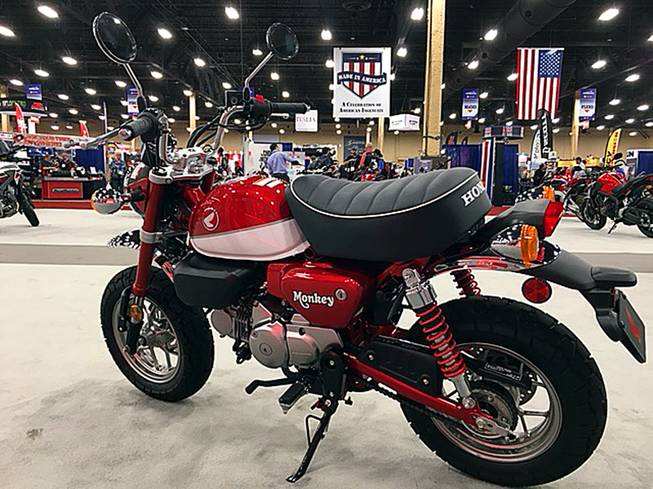
Honda’s 125cc Monkey, shown here at the International Motorcycle Expo at the Mandalay Bay Convention Center, is based on the manufacturer’s popular Mini-Trail bikes of the 1960s and 1970s. With the motorcycle industry suffering a downturn in sales, Honda believes it can attract new riders by offering small, affordable and fun bikes.
Friday, Oct. 12, 2018 | 2 a.m.
All around Badger Bob’s vendor stand in Sturgis, S.D., the town was roaring on Aug. 6.
A block south of his tent, thousands of motorcyclists were coming and going to Main Street on the first official day of Sturgis’ massive annual biker rally. Loud exhausts were common; some were so noisy that you could occasionally hear them set off car alarms.
For Badger Bob — legal name Bob Huddleson — this was once the sound of money. A lot of noise meant a lot of free-spending consumers, which equated to brisk sales of his custom helmets, clothing and accessories.
But these days, he said, bikers aren’t buying as much as they used to. The crowd at events like Sturgis has gotten older, to the point where many are on fixed incomes. They’ve gotten tighter with their money too, and many of them long ago amassed enough gear to last them the rest of their riding lives.
“Let’s say a guy’s been coming to these rallies for 25 years. By now he’s got 10 helmets, 20 vests and a warehouse full of T-shirts,” Huddleson said. “He’s not looking to buy anything.”
This isn’t just a problem for Badger Bob. The entire motorcycle industry’s sales are sagging as its core customers are aging out and younger generations aren’t replacing them.
To reverse the slide, the industry is creating new products and changing its promotional messaging in hopes of attracting a younger, more diverse group of consumers.
This weekend in Las Vegas, many of those new products will be on display to the public at the American International Motorcycle Expo, the largest such show in North America, which is expected to draw 25,000 attendees to the Mandalay Bay Convention Center.
At Honda’s display, spokesman Jon Seidel said the challenge of appealing to younger consumers and female riders prompted the manufacturer to revisit its approach in the late 1950s and early ‘60s, when it entered the U.S. market and touched off a boom in sales.
Before Honda, the American motorcycle market was dominated by large road bikes that were almost exclusively ridden by men, and often were associated with outlaw bikers. But Honda introduced lightweight and inexpensive motorcycles and marketed them to the same groups that manufacturers are trying to court today. Motorcycles went from being the transportation choice of leather-jacketed hoods to a way to get to work, the beach or the corner cafe. Using one of the iconic ad slogans from the “Mad Men” era — “You meet the nicest people on a Honda” — the Japanese manufacturer soon gained a stranglehold on the U.S. market.
“What did we do to create a market then? We built small, fun, affordable little motorcycles,” Seidel said.
In hopes of re-creating the buzz from its early days in the U.S., Honda’s new lineup includes two bikes that, in Seidel’s words, are “drizzling with our history” — the Super Cub and the Monkey. The Super Cub was created in 1958, 10 years after Honda’s founding, and became the best-selling motorized vehicle on the planet, with its 100 millionth unit sold in December 2017. (Next on the list is the Toyota Corolla, at 40 million, followed by the Ford Model T, at 16.5 million.)
Now Honda is reintroducing the bike to the U.S. market after a long absence. With a suggested retail price of $3,599, it’s designed to appeal to urban millennials in the same way it hooked their grandparents. The Monkey also is a throwback, a street-legal 125cc runabout based on Honda’s popular Mini-Trail line from the 1960s and '70s. It’s priced at $3,999.
“People talk about millennials in terms like, ‘Well, they don’t want to get their driver’s license, or they don’t want to own a vehicle,’” Seidel said. “But we firmly believe that if you offer them something that’s fun and accessible, and you give them training and they understand how to ride it, there’s a market.”
Other manufacturers are taking different approaches. Indian has introduced a street bike styled on flat-track racing machines, with lean and muscular styling designed to give it special appeal to the X Games generation. It’s the bike that extreme sports superstar Travis Pastrana used to jump the Caesars Palace fountains this year.
For Kawasaki, one strategy was to add features to one of its more popular high-tech sport bikes among younger buyers, but cut the price. At $9,999, the price will lower the profitability of each unit sold, but Kawasaki is banking that it will boost sales enough to make up for the per-unit loss.
The expo, which features more than 500 displayers of motorcycles, gear, parts and accessories, is open to the public from 9 a.m. to 4 p.m. Saturday and 9 a.m. to 5 p.m. Sunday, with demo rides offered each day.
Tickets for adult attendees are $14 per day or $22 for a two-day pass. Motorcycle parking is free, and riders also can check their riding gear at no charge.
